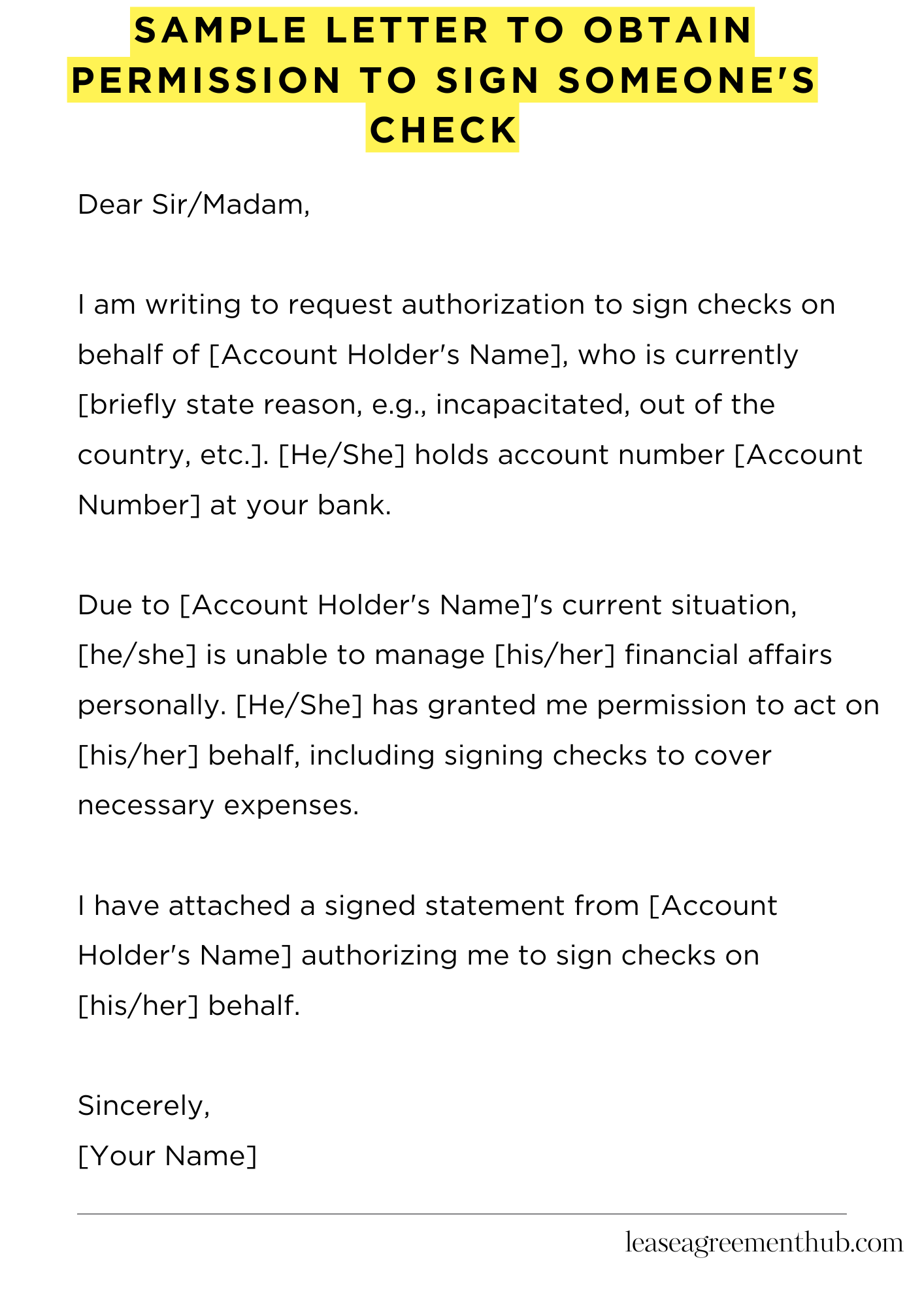Need to sign a check for someone else? You’ll likely need their permission first. A “Sample Letter To Obtain Permission To Sign Someone’s Check” is a formal way to request that permission. This is common when someone is unable to sign themselves due to illness, absence, or other circumstances.
Writing such a letter can feel daunting. Where do you even start? What information do you include?
Don’t worry, we’ve got you covered! This article provides templates and examples. These samples will make writing your permission request simple.
Sample Letter To Obtain Permission To Sign Someone’s Check
[Your Name]
[Your Address]
[Your Phone Number]
[Your Email Address]
[Date]
[Bank Name]
[Bank Address]
Subject: Authorization to Sign Checks on Behalf of [Account Holder’s Name]
Dear Sir/Madam,
I am writing to request authorization to sign checks on behalf of [Account Holder’s Name], who is currently [briefly state reason, e.g., incapacitated, out of the country, etc.]. [He/She] holds account number [Account Number] at your bank.
Due to [Account Holder’s Name]’s current situation, [he/she] is unable to manage [his/her] financial affairs personally. [He/She] has granted me permission to act on [his/her] behalf, including signing checks to cover necessary expenses.
I have attached a signed statement from [Account Holder’s Name] authorizing me to sign checks on [his/her] behalf. I have also enclosed a copy of [his/her] identification card and my identification card for verification purposes.
I would appreciate it if you could grant me the necessary authorization to sign checks on account number [Account Number]. Please let me know if you require any further documentation or information.
Thank you for your time and consideration.
Sincerely,
[Your Name]

How to Write Letter To Obtain Permission To Sign Someone’s Check
Subject Line: Clarity is Key
- Keep it succinct and unambiguous. Something like “Request for Check Signing Authorization” works wonders.
- Avoid ambiguity; ensure it immediately conveys the letter’s purpose.
Salutation: Establish a Respectful Tone
- Address the recipient formally. “Dear Mr./Ms./Dr. [Recipient’s Last Name],” is a stalwart choice.
- If you know the recipient well, and a less formal approach is warranted, “Dear [Recipient’s First Name],” might suffice. However, err on the side of formality initially.
Introduction: Declare Your Intent
- Clearly state your reason for writing in the first paragraph. For example, “I am writing to formally request authorization to sign checks on your behalf.”
- Briefly allude to the circumstances necessitating this authorization.
Body Paragraphs: Elucidate the Details
- Explain the specific period for which you require authorization. For instance, “from [Start Date] to [End Date].”
- Detail the reasons justifying your request. Be transparent and forthcoming. Is it due to temporary incapacitation or geographical constraints?
- Specify the limitations, if any. Will there be a monetary threshold for each check? Will you only be authorized to sign checks for specific purposes (e.g., medical expenses)?
- Reassure the recipient of your probity and responsible handling of their finances. Mention adhering to their directives meticulously.
Providing Specifics: The Nitty-Gritty
- Include the account number(s) for which you seek authorization. This averts any potential misinterpretations.
- Mention any relevant legal documents or agreements that may be required to formalize this authorization.
Closing: Express Gratitude and Offer Reassurance
- Express your gratitude for their consideration. A simple “Thank you for your time and consideration” is perfectly acceptable.
- Reiterate your commitment to acting in their best interest.
- Offer to provide any further clarification or documentation they may require.
Sign-off: Maintain Professionalism
- Use a formal closing, such as “Sincerely,” or “Respectfully,”.
- Follow with your full name and contact information for ease of communication. Make sure to include a phone number and email address.
Frequently Asked Questions: Permission to Sign a Check on Someone’s Behalf
This FAQ section addresses common queries regarding obtaining permission to sign checks on another person’s behalf. Understanding the proper procedures and legal considerations is crucial for ensuring financial transactions are handled appropriately.
1. What is a permission letter for signing someone’s check?
A permission letter is a formal document granting an individual the authority to sign checks on behalf of another person. It outlines the scope and limitations of this authorization.
2. When is a permission letter necessary?
A permission letter is typically required when an individual is temporarily or permanently unable to sign checks themselves, and they wish to delegate this responsibility to someone else.
3. What information should be included in the letter?
The letter should include the full legal names of both the grantor and the recipient of the permission, the specific bank account details, the duration of the permission, and a clear statement of authorization.
4. Does the permission letter need to be notarized?
While not always mandatory, notarization adds an extra layer of legal validity to the document and is often recommended, especially for significant financial transactions.
5. Where should the permission letter be submitted?
The permission letter should be submitted to the relevant financial institution where the account is held. They may have specific requirements or forms to accompany the letter.
Related: